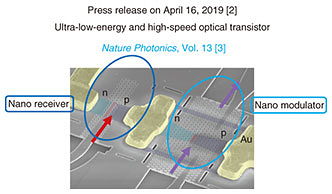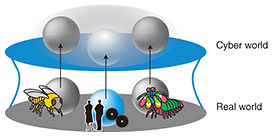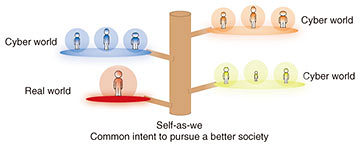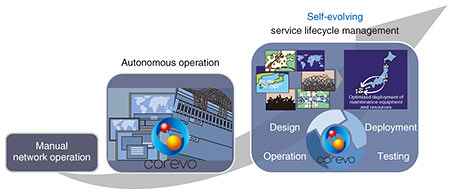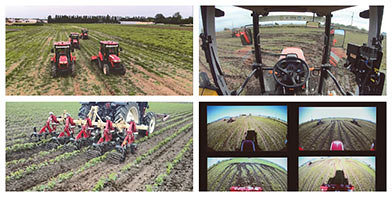 |
|||||||||||
|
|
|||||||||||
|
Feature Articles: Keynote Lectures at NTT R&D Forum 2019 Vol. 18, No. 2, pp. 17–26, Feb. 2020. https://doi.org/10.53829/ntr202002fa2  What’s IOWN? - Change the WorldOverviewThis article presents a lecture presented by Katsuhiko Kawazoe, NTT Senior Vice President, Head of Research and Development Planning Department, at NTT R&D Forum 2019 held on November 14th and 15th, 2019. The lecture introduced NTT’s latest research and development activities, focusing on Innovative Optical and Wireless Network (IOWN). Keywords: IOWN, All-Photonics Network, Digital Twin Computing, Cognitive Foundation, smart agriculture 1. Diverse value judgments and umweltsThe title of my presentation today is “What’s IOWN? - Change the World.” Last year, I spoke here on the subject: “Making the World Smart and Technology Natural.” This year, I’ll be introducing specific implementations of that theme; namely, Innovative Optical and Wireless Network, or IOWN. I’ll explain the significance of IOWN from a slightly different perspective from that of the previous presentation. 1.1 Creating innovation through learning from living thingsImagine we are suddenly away from the city. We are in the middle of a pleasant green meadow. Beautiful wildflowers are blooming all over the meadow. If I close my eyes, I can sense the fragrance of various flowers. Let’s get closer. This yellow flower is an evening primrose. It’s beautiful (Fig. 1(a)). Now, look at this image (Fig. 1(b)). This is the same primrose flower captured by Bjorn Roslett, a Norwegian scientist, from the perspective of living things that are not human beings. The yellow primrose that we humans see looks like this to those organisms.
They are honeybees. Honeybees can see ultraviolet rays, which humans cannot. The flower looks yellow to human eyes. But, if you could see ultraviolet rays, you could detect that there is pollen and nectar in the central part of the flower. For honeybees, a flower looking beautiful is of no value. However, information about where they can collect nectar and pollen is very valuable to them. Let’s go under the sea. There’s something in the gloom. It’s a squilla. It is said that squillae have the best visual system of any animal. They have receptors that can discriminate as many as 12 different colors. Humans discriminate intermediate colors based on three primary color (red, blue, and green) receptors and information processing in the brain. In contrast, squillae sense things extremely rapidly with their 12-color receptors and minimal information-processing (Fig. 2). What’s of value to them is a high-speed response to capture animals moving in the water. In the case of honeybees, what’s remarkable is that they can see what humans cannot. What is notable about squillae is that they have a mechanism for directly processing information.
For a long time, humans have created innovation through learning from other living things, especially by mimicking them. The designs of jet planes and trains are examples of using such a mimicry approach. We want to take it a step further. Every animal species has its unique sensory world in which it lives. Jakob von Uexküll, a German biologist, called this interpretation “umwelt” to signify a self-centered world, using the German term for “environment.” It means that how things look varies depending on the viewer. Accordingly, the type of information a species transmits and the way it processes information vary depending on the value judgment of that species. 1.2 Technology to capture diverse value judgmentsAn example of diversity in value judgment can be seen in the recent developments in smartphones. For example, the latest models have multiple camera sensors with different focal lengths and exposures and incorporate technology for taking photos that best suit the needs of the user. One of the basic research projects exhibited in this R&D Forum is the optical meta-surface. Its minute, nano-sized structure makes it possible to manipulate wavelength, polarization, and phase of light at will. We are hoping that this technology will enable us to produce sensors comparable to the eyes of honeybees. We believe that if we regard the world as a field that holds diverse values, and if we can use information hitherto unused due to the apparent absence of any value in it, we will be able to create new values that we could have never previously imagined. A connected car is an obvious example. What is vital for drivers is the ability to confirm, instantaneously and accurately, that the road ahead is safe. Getting a clear image of the road using 4K or 8K is less important than exhaustively capturing information that can be used to determine if the road surface is icy or if there are any dangerous objects on the road. 2. IOWN2.1 Aims of IOWNThe conventional motivations for developments in information and communication processing have been to increase speed, capacity, and efficiency using digital signal processing. For example, the Internet has proven useful for many services and business activities through adoption of common protocols to provide an inexpensive network based on the “best-effort” principle. However, if we are to evolve technology to simultaneously capture the diverse values that exist in the world, we need to penetrate new technical domains. Both the umwelt of honeybees and that of squillae actually exist in this world. However, these types of worlds are missing from the current world of the Internet protocol (IP) or the digital world. We want to convey sufficient information, process it appropriately based on diverse values, and provide benefits naturally. This is innovation that can be achieved through IOWN (Fig. 3).
With IOWN, we aim to create an innovative information processing base that will process a greatly expanded volume of information than is currently possible, thereby bring about an innovative means to break out of conventional technical constraints, such as power consumption limitations. Wouldn’t you agree that, these days, the Internet is used for almost everything? For example, there is no need for everything to be connected to the Internet, but Internet of Things (IoT) is taken for granted. IOWN is our initiative for mustering the courage to shift from the logic of sheer numbers, the logic that supports our attachment to the Internet, to the logic of values. For this purpose, we are pursuing a transition from digital to natural and, equally important, from electronics to photonics, which is necessary for overcoming technical limitations. Through these two transitions, we aim to provide ultimate safety, security, and reliability, enable sustainable economic growth in an environmentally friendly manner, and achieve local and global optimization that is tolerant of diversity. 2.2 IOWN Global ForumOn October 31, NTT, Intel Corporation (Intel), and Sony Corporation (Sony) announced the establishment of a new industrial forum called IOWN Global Forum for the purpose of cooperating with global partners in driving research and development (R&D) for IOWN. During my presentation, Ms. Asha Keddy from Intel and Mr. Masayuki Hattori from Sony, both heading up IOWN projects in their respective companies, were invited to come to the podium to speak about their expectations for IOWN. 2.3 Elements of IOWNIOWN consists of three elements.
I will explain these elements in more detail and conclude by focusing on the “W” (wireless technology) in IOWN. 3. All-Photonics NetworkThe first element is the All-Photonics Network. The intent of all-photonics is not necessarily to replace all electrical components with optical parts but, rather, to use optical technology everywhere. 3.1 Photonics-electronics convergence technologyOptical technology was first applied to long-distance transmission. The fact that Japan is a leading country in the penetration of FTTH (fiber-to-the-home) owes much to NTT’s optical technology. However, information processing components, such as CPUs (central processing units), are fabricated using electronic technology called complementary metal oxide semiconductor (CMOS). IOWN applies optical technology not only to networks but also inside semiconductors in terminals and servers. The intent is to expand the use of photonics technology. The basis for achieving all-photonics technology is photonics-electronics convergence, which makes it possible to process light and electricity on a single chip. This technology is already beginning to be used in network interfaces called coherent optical subassembly (COSA). Silicon photonics technology is used to fabricate tiny optical transceivers and an optoelectronic converter on silicon chips. The left photo in Fig. 4 shows an initial 40-Gbit/s optical transmission device that did not use photonics-electronics convergence. The device in the right photo uses COSA. The respective sizes of the two devices are dramatically different [1].
This photonics-electronics convergence technology will be applied even to information processing parts (Fig. 5). Initially, optics will be brought close to chips. This stage may be called “co-packaged optics.” Then, optics will be applied to communication between chips. IOWN aims at achieving the fabrication depicted in the right figure to dramatically reduce power consumption. Optical input/output functions are directly fabricated on CMOS chips to produce a photonics-electronics convergence processor in which optical processing and electrical processing converge.
NTT was the first to develop an optical transistor based on photonics-electronics convergence that can operate at high speed with extremely low power consumption [2] (Fig. 6). In April 2019, a paper on this transistor was published in Nature Photonics in the UK [3]. This invention reduces power consumption by about two orders of magnitude in comparison to that of a transistor based on conventional photonics-electronics convergence. The invention of this optical transistor capable of operating with the world’s smallest energy consumption was, in fact, the seed for the birth of the IOWN concept.
3.2 Values of the All-Photonics NetworkIn the All-Photonics Network, it is conceivable that a function or service can be assigned to each wavelength. For example, let us consider critical services, such as automated driving and remote medical operations. It is difficult to eliminate misgivings about the safety of medical operations conducted via the Internet because the latter operates on the “best-effort” principle. However, with IOWN, it is possible, depending on the service used, that, instead of converting data into IP packets, we could provide a dedicated ultra-low-latency circuit with its bandwidth guaranteed by its large-capacity wavelength, a circuit that is dedicated to each individual function. This is similar to the mechanism whereby squillae use 12 types of receptors to achieve a rapid response with minimal information processing. What other things will a photonics network enable us to do? Currently, NTT is collaborating with Professor Katori of the University of Tokyo to connect optical lattice clocks, which he invented, through NTT’s photonics network. An optical lattice clock has achieved 10−18 level of total uncertainties of clock frequency. This is about 1000 times more precise than can be obtained with a conventional cesium-based atomic clock. It is so accurate that its degree of error will be less than a single second, even 30 billion years from now. What could we do with such a clock? For example, do you think time at the summit of Mt. Fuji advances at exactly the same rate as time down on Tokyo Bay? According to Albert Einstein’s general theory of relativity, the higher a place is, the faster time elapses. By connecting optical lattice clocks at these two locations via a photonics network, you could measure the difference in altitude between the two places in real time, even if the difference is as small as a centimeter. If this can be done, you could measure volcanic activity and crustal movements and use the measurements to provide safety information or manage infrastructures. 4. Digital Twin ComputingNext, I want to talk about Digital Twin Computing. There are two major points. The first is creation of large-scale and diverse cyber worlds that perceive the entire world based on the umwelts that I mentioned earlier and on various value judgements. The other is self-awareness for leading a contented life. 4.1 Cyber worlds that perceive the entire worldToday, digital twin technology is attracting attention across a wide range of industrial fields. However, most current approaches are focused on creating a single umwelt in cyberspace, which is simply a copy of the real world. However, as can be seen in the examples of the umwelts of bees and squillae, our world is full of various types of information that humans cannot perceive. Thanks to technical innovation, humankind will be able to go beyond its own umwelt and access all types of available information. We are aiming to capture everything in the real world and re-present it in cyberspace so that we can create types of values previously inconceivable to humans (Fig. 7).
4.2 Self-awareness for leading a contented lifeHowever, we believe that there are issues that cannot be resolved through technology alone. They have to do with ethics. When our lives expand beyond the real world to embrace cyberspace, issues will arise that cannot be measured based on conventional value judgements, issues that relate to new value judgments, ethics, and morals. Even today, unethical statements are posted on Internet message boards, and the posters are protected by anonymity. In the world of computer games, you can easily take the life of an opponent’s character. At a time when our lives are extending into cyberspace, and what happens there becomes a part of everyday life, can we remain complacent about the current state of ethics in cyberspace? Let me explain a little about the joint research with Professor Deguchi of Kyoto University, which President Sawada referred to. Being a philosopher, Professor Deguchi propounds a philosophical concept that he calls “self-as-we.” His idea is that an individual does not exist in isolation but, rather, exists in conformity with the objective or intent of the world related to him or her. For example, the mindset to pursue a better society. If this mindset could be shared as a common intent and used to link the real world with cyberspace, we would be able to realize a more contented society. In other words, in a world made possible by IOWN, the real world and cyberspace are independent but share the same intent. We define this intent as “self.” This is our concept of a parallel world in which the real and cyber worlds embrace each other (Fig. 8).
4.3 Avatar and digital twinSince my talk has become somewhat abstract, let me give you a specific example of a simulation of myself. This is a very simple example. The camera there is filming me. An image of myself is extracted from the captured image to create my avatar. However, what you see is but a copy of me. In the future, once IOWN has been implemented, it will be possible to create an avatar that shares my sense of values. Both his image and his voice can be synthesized to appear and sound almost exactly as I look and speak. However, this is not simply a copy of me. He can think and speak on his own. My avatar-cum-digital twin will do a lot of things on my behalf. For example, suppose there’s a phone call for me while I’m making a presentation. He can recognize my whisper and answer the call for me. He can provide additional information. For example, he estimates the time remaining in my presentation and tells the caller when I can call back. Furthermore, since my twin is closely linked to society via cyberspace, he can obtain information that I cannot perceive. For example, he can measure the degree of excitement of the audience and give me advice about improving my presentation style or information that broadens my perspective. He can also predict my future state of health based on the medical data of many people and the trends of various technologies and industries that are not necessarily confined to the healthcare field. He may give me a sense of enjoyment by virtually experiencing an adventure that I would not dare to undertake in the real world and conveying his excitement to me. Several necessary basic technologies are already being developed. The technologies for recognizing whispers and synthesizing a person’s voice have already reached a practical level. As part of its health databank service, NTT DATA provides a service that predicts the user’s likely rate of incidence of lifestyle-related diseases a few years from now based on past health examination data of NTT Group employees. We are also collaborating with a life insurance company toward developing this type of business. If the real world and cyber world can have a good relationship, a better future will come about. When it does, people’s lives may change as follows [4]. For example, while you take a day off, your twin in the cyber world can hold a discussion with the twin of another person and work according to your thinking and knowledge; you only get involved in the discussion or work when it is necessary to make a critical decision. What is important is that the real you and your twin share thoughts that each other most cares about. 5. Cognitive Foundation®Next, I’ll explain the Cognitive Foundation. The Cognitive Foundation flexibly controls and harmonizes all ICT resources. Its key points are self-evolution and optimization. 5.1 Self-evolving service lifecycle managementSome months ago, Japan was hit by two powerful typhoons: Typhoons 15 (Faxai) and 19 (Hagibis). They had a tremendous impact on telecommunications services as well. I sincerely extend my sympathy to all those affected. NTT has been developing technology for using AI (artificial intelligence) to detect failures based on logs issued by telecommunications infrastructure devices and to deal with them autonomously. We’ll move one step ahead of that. We’ll enter into the Cognitive Foundation a wide variety of information that cannot be monitored by the network, such as weather prediction information about the strength and path of an approaching typhoon and information about planned events. We’ll also enter information about various umwelts, which I described earlier. Based on the collected information, the system will optimize the network autonomously. It will plan and execute measures against a disaster before it occurs. It will make predictions and evolve itself accordingly. We are aiming at such self-evolving service lifecycle management (Fig. 9).
5.2 CradioWe will also work on the development of the “W” in IOWN; namely, wireless technology. Today, there are various wireless systems. In addition to conventional 4G/LTE (fourth-generation mobile communications/Long-Term Evolution), there is satellite communication, Wi-Fi, WiMAX, LPWA (low power wide area) for IoT, fifth-generation mobile communications (5G), Local 5G, and so on. The world of wireless technology has become very complex. NTT is studying technology for optimizing wireless access so that the user can enjoy access best suited to his or her situation without any need to be conscious of what wireless system is used, how it is to be used, or what network service is used. This is “Cradio.” Cradio proactively optimizes wireless connections based on the location and predicted traffic congestion and quality. For example, a person urgently wishes to send a message to me at Tokyo Station, where Wi-Fi throughput is low. It will become possible for the sender’s side to control the network to select a wireless access system that is optimal for reaching me. The Cognitive Foundation will incorporate wireless control technology that enables the user to make wireless access optimal for his or her particular location, application, and situation, without needing to know what wireless technology will be used or which company will provide the service. 5.3 Future development of wireless networksWhen combined with the All-Photonics Network, wireless access technology in IOWN will be able to penetrate new areas. A world is waiting in which things can be connected, quite literally, everywhere through IOWN, whether they are under the sea, in the air, or in outer space. We are undertaking R&D for this purpose. For example, we are combining a physical quantity in quantum mechanics called orbital angular momentum with NTT’s space-division multiplexing technology that uses multiple antennas and a technology called multiple-input and multiple-output (MIMO). Combining these, we are working on developing world-leading large-capacity wireless transmission. To date, we have achieved a wireless transmission rate of 200-Gbit/s. We are seeking to achieve a wireless transmission rate on the order of terabits per second, which is 100 times faster than that of 5G. We are also studying undersea wireless communication that can be used by heavy machines and drones in underwater situations. A drawback of conventional visible light communication is that transmission distance is significantly reduced when water becomes muddy. Instead, we have applied MIMO technology to acoustic communication that uses ultrasonic waves. We have achieved a transmission rate that is as much as two orders of magnitude higher than that of conventional acoustic communication. This communication system will make it possible to transmit high-definition video. We are also developing wireless transmission in outer space. NTT has concluded an agreement with Japan Aerospace Exploration Agency (JAXA) on a vision-sharing-type joint research project with the aim of developing an ultra-high-capacity and secure optical and wireless communication infrastructure that can seamlessly connect outer space and ground stations. It will combine JAXA’s space-quality system configuration technology with NTT’s optical and wireless network technology and the IOWN concept to establish a new social infrastructure in space. We will start with joint research on developing unprecedented satellite MIMO communication between a low-orbit satellite and an earth station. Once this has been implemented, we can contribute to the establishment of a space communication infrastructure that enables ultra-high-speed and high-capacity communication in outer space. 6. World made possible by IOWNThus far, I have explained the three elements of IOWN. Now, I want to introduce some examples of how IOWN can be useful for industries. 6.1 Smart agricultureThe NTT Group has signed an agreement involving a corporation, academic institution, and a city government; NTT, Hokkaido University, and Iwamizawa City in Hokkaido. The aim of this project is to develop world-leading smart agriculture using cutting-edge agricultural robot technology and ICT. We have here with us Professor Noguchi of Hokkaido University, who will work with the NTT Group on this project. Kawazoe: Professor Noguchi, what is the biggest problem confronting Japanese agriculture today? Professor Noguchi: A big problem with Japanese agriculture is the labor shortage. The number of farmers has decreased by 15% over the last five years. The average age among farmers is 67. More than 65% of all farmers are 65 or older. Aging of farmers is a serious problem. Kawazoe: Are you finding NTT’s technology and IOWN useful for your smart agriculture project, which was initiated in June of this year (2019)? Professor Noguchi: Since the agreement was concluded, we are already commanding great attention. We have been visited by the Cabinet Office, relevant ministries, and delegates from the German Bundestag and have been interviewed by overseas media. It is a great honor to work with the NTT Group on developing world-leading smart agriculture. Through this collaboration, we are conducting a test of remote monitoring using an extremely precise positioning service provided by NTT DOCOMO based on its base stations and 5G (Fig. 10). The Japanese government is aiming at implementing robot farming that will be made possible by remote monitoring and automated driving by 2020. I believe that our team is the most advanced in pursuing these capabilities. The ground resolution of monitored video is 2 mm when full high definition is used, and 1 mm when 4K is used. When such high-definition video becomes available, it can be used not only for simple monitoring but also for surveying the growth rates of farm products and identifying incidences of diseases. This is a very promising technology.
Kawazoe: One last question. Earlier I talked about technology for achieving sensing capabilities like those of bees and squillae. I think that this technology would be particularly useful in the field of agriculture. What do you think? Professor Noguchi: Yes, I totally agree with you. Today, it has become important to reduce the use of pesticides to maintain biodiversity. For this purpose, biological prevention, that is, robot insects that have a mechanism whereby natural predators eat pest insects, holds great potential. Kawazoe: Thank you. Let’s work together to achieve smart agriculture. Thank you for making the time to join us, here. 6.2 Heart-warming elderly careFinally, I’d like to introduce to you our activities for supporting dementia sufferers. Today, there are numerous research projects looking into ways to prevent the development of dementia. However, there is a paucity of research on ways to support people who have already developed dementia. We are studying technology for enabling people with dementia to lead rewarding lives. Please watch this concept video [5] (Fig. 11).
This person suffers from dementia and she seems to have forgotten the name of her son. The son brings her a cube-shaped device. To help her recall her memories, her digital twin displays videos of his childhood. Watching the videos, she tries her best to recall something. A pendant-like device that she is wearing senses her emotions and thoughts and finds a piece of music that can awaken her memory. She seems to have recaptured something. Her grandson comes in. This seems to be his birthday. Her digital twin records information about her grandson as a new memory. We intend to pursue R&D with the aim of bringing about a future in which everyone can be connected to his or her memories, be connected to other people, and enjoy a contented life supported by mental and physical health. 7. IOWN for the futureIOWN is aimed at 2030 and beyond. Abnormal climatic conditions, rising medical costs, the aging of populations, and a greater demand for ensuring food safety—besides these known social issues that currently concern us, we will certainly be confronted with risks that we have never previously experienced. To meet these challenges, humankind will continue to pursue technical innovation. It will be necessary to surmount a high wall, unconstrained by stereotypes or fear of taking risks. To protect the global environment and ensure sustainable development, we should think outside the box and pursue the welfare and prosperity of humankind with an enhanced zeal for technical innovation. The IOWN concept represents our commitment to thinking deeply about and creating the future of humankind in cooperation with many other people and organizations. IOWN for the future: What I have introduced to you today is but a tiny, tiny start that NTT has formulated. We will expand this concept by working in collaboration with many people and organizations. Thank you. References
Trademark notesAll brand, product, and company/organization names that appear in this article are trademarks or registered trademarks of their respective owners. |
|||||||||||






